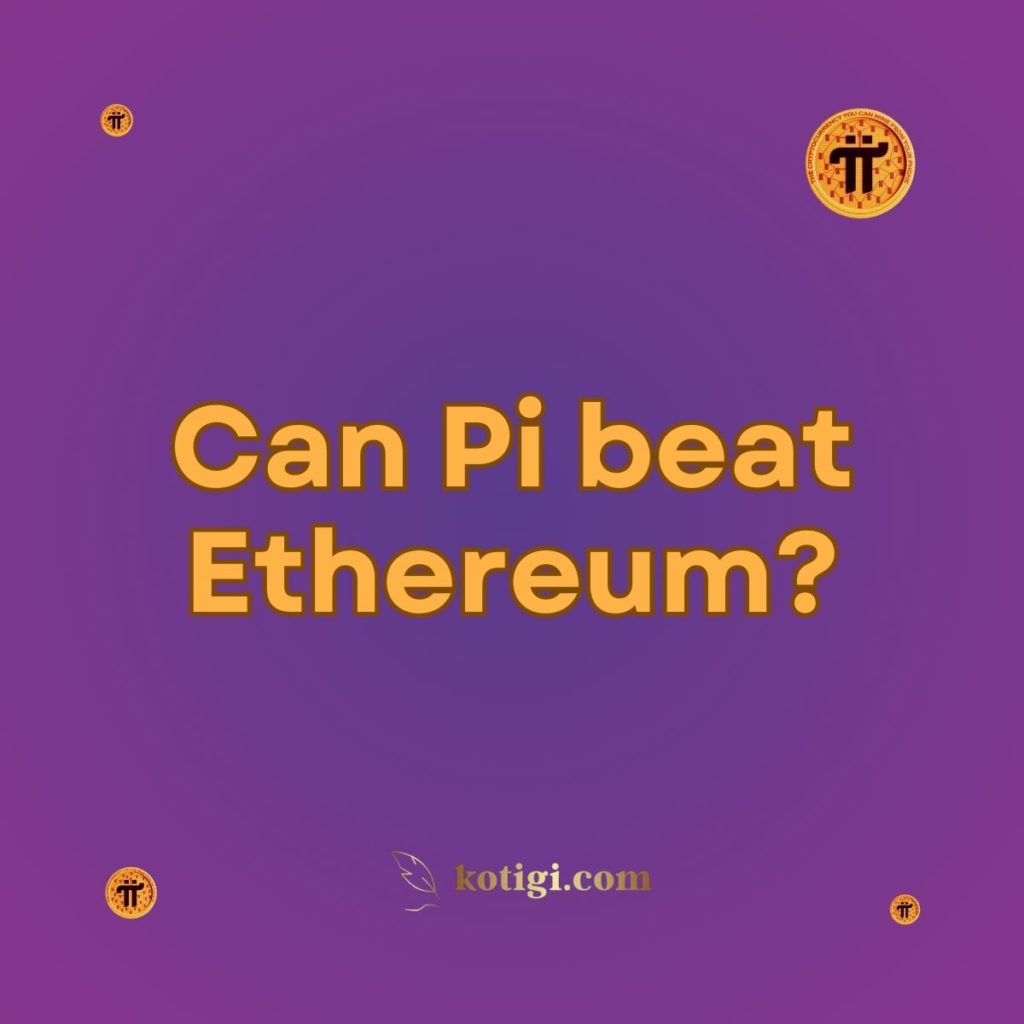
Pi Network and Ethereum are two distinct blockchain platforms, both with ambitious goals in the cryptocurrency space. While Ethereum has already established itself as a leading blockchain for decentralized applications (dApps) and smart contracts, Pi Network is still in its developmental phases. This article explores whether Pi has the potential to “beat” Ethereum in terms of adoption, functionality, and long-term success.
Understanding Pi Network
Pi Network is a cryptocurrency platform that allows users to mine Pi coins using their mobile phones. Launched in 2019 by a team of Stanford graduates, Pi Network’s primary goal is to create an accessible, user-friendly cryptocurrency that can be mined without the need for expensive hardware or high energy consumption.
How Pi Works
Pi Network uses a mobile app that allows users to mine coins by checking in once a day. Unlike Bitcoin and Ethereum, which rely on energy-intensive proof-of-work (PoW) mechanisms, Pi utilizes a consensus algorithm based on the Stellar Consensus Protocol (SCP). This allows Pi mining to be energy-efficient and mobile-friendly.
Pi Network’s Development Stages
- Phase 1 (2019): Pi launched its beta version, where users could mine Pi coins on their mobile phones.
- Phase 2 (2020): The network entered its Testnet phase, focusing on blockchain testing and development.
- Phase 3 (2021–present): The Enclosed Mainnet was launched, allowing users to interact within the Pi ecosystem. However, Pi is not yet listed on external exchanges, and its value remains speculative.
Pi Network’s final phase, the Open Mainnet, is expected to bring more functionality and the ability for users to trade Pi coins on exchanges.
Understanding Ethereum
Ethereum, launched in 2015 by Vitalik Buterin, is a decentralized platform that enables developers to build dApps, execute smart contracts, and deploy decentralized finance (DeFi) applications. As the second-largest cryptocurrency by market cap (after Bitcoin), Ethereum is often viewed as a critical infrastructure for the blockchain world.
Key Features of Ethereum
- Smart Contracts: Ethereum introduced the concept of smart contracts, self-executing contracts with the terms of the agreement directly written into code.
- Ethereum Virtual Machine (EVM): The EVM enables developers to build decentralized applications on the Ethereum network, making it a hub for innovation in the blockchain space.
- Transition to Proof-of-Stake (PoS): Ethereum is transitioning from a proof-of-work (PoW) mechanism to a more energy-efficient proof-of-stake (PoS) system through Ethereum 2.0, making it more sustainable and scalable.
Comparing Pi Network and Ethereum
While Pi Network and Ethereum are both blockchain projects, they serve different purposes and are at very different stages of development. Let’s compare the two across several key areas to assess whether Pi could potentially “beat” Ethereum.
Accessibility and Mining
Pi Network is designed to be accessible to the average user. Mining Pi requires only a smartphone and minimal effort, with users simply logging into the Pi app daily to continue mining. Pi’s goal is to democratize cryptocurrency, making it available to anyone, regardless of technical expertise or access to expensive hardware.
Ethereum, on the other hand, originally required substantial computational power and energy for mining, although it is now transitioning to a more sustainable proof-of-stake (PoS) system with Ethereum 2.0. While Ethereum’s move to PoS lowers the barrier to entry for validation, it still requires more technical knowledge and resources compared to Pi.
Development and Adoption
Ethereum has a robust ecosystem of dApps, smart contracts, and decentralized finance (DeFi) applications. Thousands of developers are building on Ethereum, making it the go-to platform for blockchain innovation. Ethereum’s widespread adoption by developers, businesses, and institutional investors gives it a significant advantage in the blockchain space.
Pi Network, by contrast, is still in its development stages and has yet to prove itself as a fully functional blockchain ecosystem. While Pi has a large and growing user base—more than 35 million users as of 2023—the network is primarily composed of individuals mining Pi on mobile devices. Pi’s ecosystem remains underdeveloped, with fewer dApps and use cases compared to Ethereum.
Decentralization and Security
Ethereum is one of the most decentralized blockchain platforms, with thousands of nodes running the network. Its decentralization makes it more secure and resistant to censorship or interference. Ethereum’s smart contract capabilities also make it a powerful tool for decentralized applications, allowing developers to create secure, trustless solutions.
Pi Network, on the other hand, is still in its early stages, and its decentralization and security have yet to be fully proven. Pi’s consensus mechanism (SCP) is less energy-intensive but also less battle-tested compared to Ethereum’s. As Pi Network continues to develop, it will need to demonstrate that it can provide the same level of security and decentralization as more established platforms like Ethereum.
Scalability and Future Potential
Ethereum has faced scalability issues, with network congestion and high gas fees being major concerns. However, the ongoing upgrade to Ethereum 2.0 aims to resolve these problems by introducing sharding and a proof-of-stake consensus mechanism. Once these upgrades are fully implemented, Ethereum is expected to handle a significantly higher volume of transactions and reduce fees.
Pi Network has the potential to scale due to its mobile-first approach and lightweight consensus mechanism. However, since Pi has not yet launched its Open Mainnet, it’s difficult to assess its scalability compared to Ethereum. Much of Pi’s future potential depends on how well it can build out its ecosystem and handle large-scale adoption once the network is fully operational.
Can Pi Beat Ethereum?
Now that we’ve compared Pi and Ethereum across key factors, the question remains: Can Pi beat Ethereum?
Pi’s Strengths
- Accessibility: Pi is incredibly easy to use and accessible to a global audience. Its mobile-first approach has the potential to onboard millions of users who may not have the resources or technical knowledge to participate in traditional cryptocurrency mining.
- Large User Base: Pi has already amassed a substantial user base, which could provide a foundation for future growth. If Pi can transition these users into an active ecosystem of decentralized applications, it could become a competitive force in the blockchain world.
Ethereum’s Strengths
- Established Ecosystem: Ethereum is already the leading platform for smart contracts, dApps, and decentralized finance. With thousands of projects built on Ethereum and a massive developer community, it has a significant head start.
- Proven Security and Decentralization: Ethereum has a track record of security and decentralization, making it a trusted platform for developers and businesses alike.
Challenges for Pi
For Pi to “beat” Ethereum, it would need to overcome several significant challenges:
- Ecosystem Development: Pi’s ecosystem is still in its infancy. While it has a large user base, Pi has yet to build out a robust network of dApps, smart contracts, or other blockchain applications. Ethereum, by contrast, is already a fully functioning platform with thousands of use cases.
- Exchange Listing and Liquidity: Pi is not yet listed on any major exchanges, which limits its liquidity and market value. Until Pi is tradable and has a clearly defined price, it remains a speculative asset. Ethereum, on the other hand, is widely traded and highly liquid.
- Technological Maturity: Ethereum’s technology, while not without its challenges, is mature and widely used. Pi is still in its developmental stages, and it’s unclear how well it will perform once it reaches full operational capacity.
Conclusion
While Pi Network presents an exciting and accessible vision for cryptocurrency, it is unlikely to “beat” Ethereum in the near future. Ethereum has a well-established ecosystem, a strong developer community, and a proven track record of security and decentralization. That said, Pi’s mobile-first approach and growing user base could allow it to carve out its niche, particularly if it can successfully build an ecosystem of decentralized applications and services. Ultimately, both platforms serve different purposes, and Pi will need to prove itself as a viable competitor to Ethereum over time.
Can Pi beat Ethereum?
While Pi Network is accessible and has a large user base, it is still in its early stages of development. Ethereum, on the other hand, has a well-established ecosystem, proven security, and widespread adoption. Pi’s success will depend on its ability to build out a functional ecosystem and achieve widespread adoption, but it is unlikely to surpass Ethereum in the near future.
Key Takeaways
- Pi Network is accessible and easy to mine, but it is still in its developmental stages.
- Ethereum has an established ecosystem with thousands of dApps, smart contracts, and decentralized finance projects.
- Pi has yet to be listed on exchanges, limiting its liquidity and market value.
- Ethereum is more secure and decentralized, with a proven track record in the blockchain space.
- Pi has the potential to succeed in its niche, but it is unlikely to surpass Ethereum in the near future.





